ECO mode JEEP GLADIATOR 2023 Manual PDF
[x] Cancel search | Manufacturer: JEEP, Model Year: 2023, Model line: GLADIATOR, Model: JEEP GLADIATOR 2023Pages: 448, PDF Size: 17.37 MB
Page 405 of 448
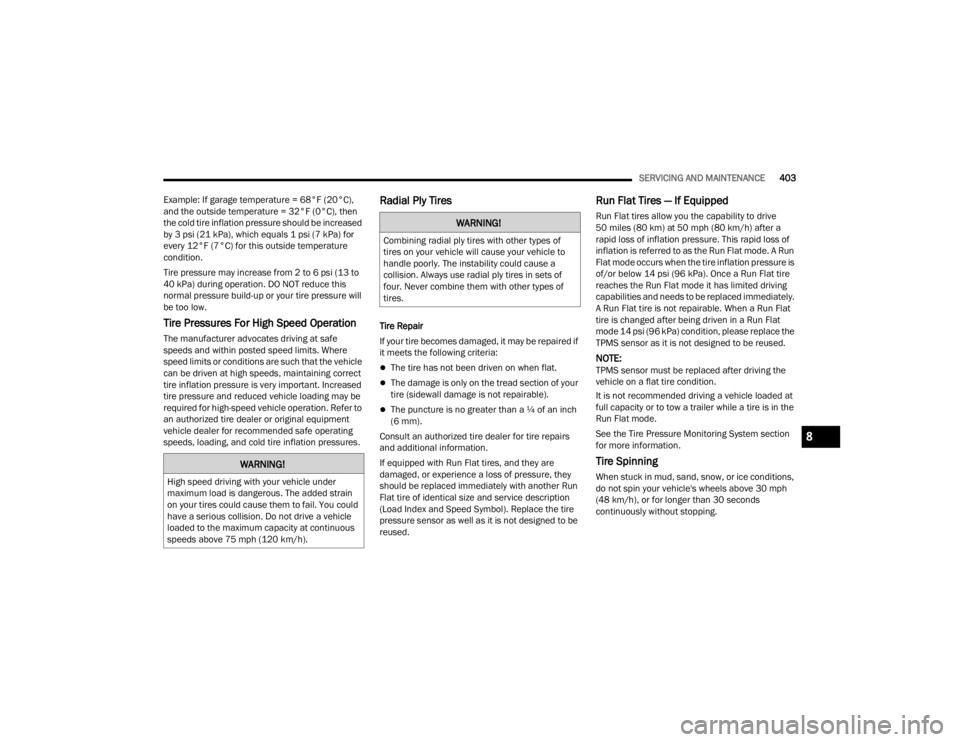
SERVICING AND MAINTENANCE403
Example: If garage temperature = 68°F (20°C),
and the outside temperature = 32°F (0°C), then
the cold tire inflation pressure should be increased
by 3 psi (21 kPa), which equals 1 psi (7 kPa) for
every 12°F (7°C) for this outside temperature
condition.
Tire pressure may increase from 2 to 6 psi (13 to
40 kPa) during operation. DO NOT reduce this
normal pressure build-up or your tire pressure will
be too low.
Tire Pressures For High Speed Operation
The manufacturer advocates driving at safe
speeds and within posted speed limits. Where
speed limits or conditions are such that the vehicle
can be driven at high speeds, maintaining correct
tire inflation pressure is very important. Increased
tire pressure and reduced vehicle loading may be
required for high-speed vehicle operation. Refer to
an authorized tire dealer or original equipment
vehicle dealer for recommended safe operating
speeds, loading, and cold tire inflation pressures.
Radial Ply Tires
Tire Repair
If your tire becomes damaged, it may be repaired if
it meets the following criteria:
The tire has not been driven on when flat.
The damage is only on the tread section of your
tire (sidewall damage is not repairable).
The puncture is no greater than a ¼ of an inch
(6 mm).
Consult an authorized tire dealer for tire repairs
and additional information.
If equipped with Run Flat tires, and they are
damaged, or experience a loss of pressure, they
should be replaced immediately with another Run
Flat tire of identical size and service description
(Load Index and Speed Symbol). Replace the tire
pressure sensor as well as it is not designed to be
reused.
Run Flat Tires — If Equipped
Run Flat tires allow you the capability to drive
50 miles (80 km) at 50 mph (80 km/h) after a
rapid loss of inflation pressure. This rapid loss of
inflation is referred to as the Run Flat mode. A Run
Flat mode occurs when the tire inflation pressure is
of/or below 14 psi (96 kPa). Once a Run Flat tire
reaches the Run Flat mode it has limited driving
capabilities and needs to be replaced immediately.
A Run Flat tire is not repairable. When a Run Flat
tire is changed after being driven in a Run Flat
mode 14 psi (96 kPa) condition, please replace the
TPMS sensor as it is not designed to be reused.
NOTE:TPMS sensor must be replaced after driving the
vehicle on a flat tire condition.
It is not recommended driving a vehicle loaded at
full capacity or to tow a trailer while a tire is in the
Run Flat mode.
See the Tire Pressure Monitoring System section
for more information.
Tire Spinning
When stuck in mud, sand, snow, or ice conditions,
do not spin your vehicle's wheels above 30 mph
(48 km/h), or for longer than 30 seconds
continuously without stopping.
WARNING!
High speed driving with your vehicle under
maximum load is dangerous. The added strain
on your tires could cause them to fail. You could
have a serious collision. Do not drive a vehicle
loaded to the maximum capacity at continuous
speeds above 75 mph (120 km/h).
WARNING!
Combining radial ply tires with other types of
tires on your vehicle will cause your vehicle to
handle poorly. The instability could cause a
collision. Always use radial ply tires in sets of
four. Never combine them with other types of
tires.
8
23_JT_OM_EN_USC_t.book Page 403
Page 413 of 448
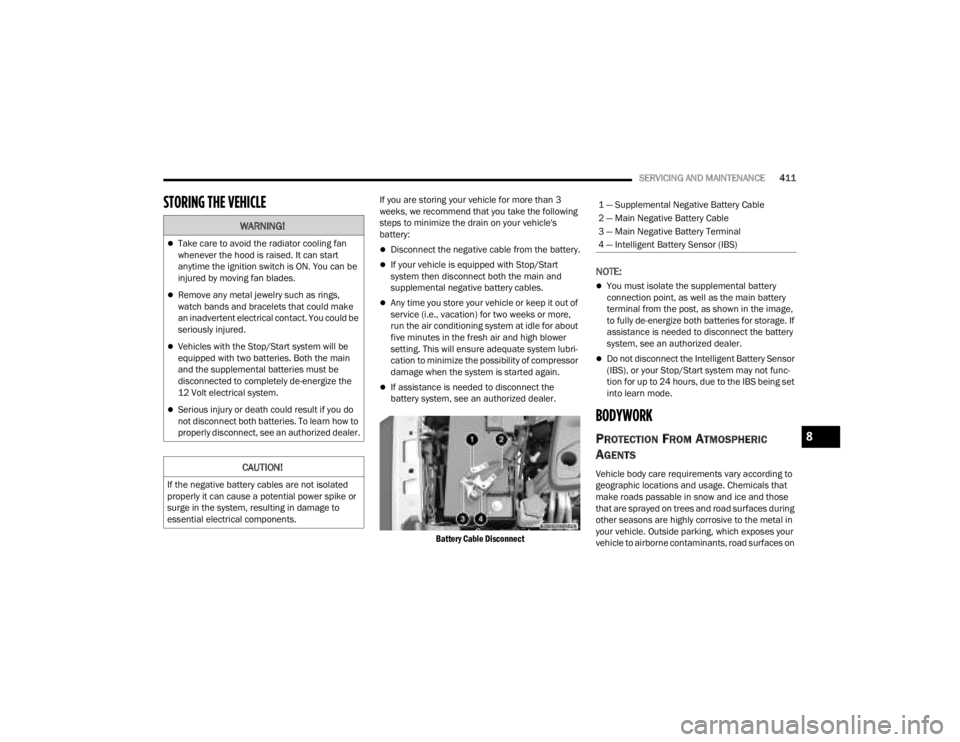
SERVICING AND MAINTENANCE411
STORING THE VEHICLE If you are storing your vehicle for more than 3
weeks, we recommend that you take the following
steps to minimize the drain on your vehicle's
battery:
Disconnect the negative cable from the battery.
If your vehicle is equipped with Stop/Start
system then disconnect both the main and
supplemental negative battery cables.
Any time you store your vehicle or keep it out of
service (i.e., vacation) for two weeks or more,
run the air conditioning system at idle for about
five minutes in the fresh air and high blower
setting. This will ensure adequate system lubri-
cation to minimize the possibility of compressor
damage when the system is started again.
If assistance is needed to disconnect the
battery system, see an authorized dealer.
Battery Cable Disconnect
NOTE:
You must isolate the supplemental battery
connection point, as well as the main battery
terminal from the post, as shown in the image,
to fully de-energize both batteries for storage. If
assistance is needed to disconnect the battery
system, see an authorized dealer.
Do not disconnect the Intelligent Battery Sensor
(IBS), or your Stop/Start system may not func -
tion for up to 24 hours, due to the IBS being set
into learn mode.
BODYWORK
PROTECTION FROM ATMOSPHERIC
A
GENTS
Vehicle body care requirements vary according to
geographic locations and usage. Chemicals that
make roads passable in snow and ice and those
that are sprayed on trees and road surfaces during
other seasons are highly corrosive to the metal in
your vehicle. Outside parking, which exposes your
vehicle to airborne contaminants, road surfaces on
WARNING!
Take care to avoid the radiator cooling fan
whenever the hood is raised. It can start
anytime the ignition switch is ON. You can be
injured by moving fan blades.
Remove any metal jewelry such as rings,
watch bands and bracelets that could make
an inadvertent electrical contact. You could be
seriously injured.
Vehicles with the Stop/Start system will be
equipped with two batteries. Both the main
and the supplemental batteries must be
disconnected to completely de-energize the
12 Volt electrical system.
Serious injury or death could result if you do
not disconnect both batteries. To learn how to
properly disconnect, see an authorized dealer.
CAUTION!
If the negative battery cables are not isolated
properly it can cause a potential power spike or
surge in the system, resulting in damage to
essential electrical components.
1 — Supplemental Negative Battery Cable
2 — Main Negative Battery Cable
3 — Main Negative Battery Terminal
4 — Intelligent Battery Sensor (IBS)
8
23_JT_OM_EN_USC_t.book Page 411
Page 415 of 448
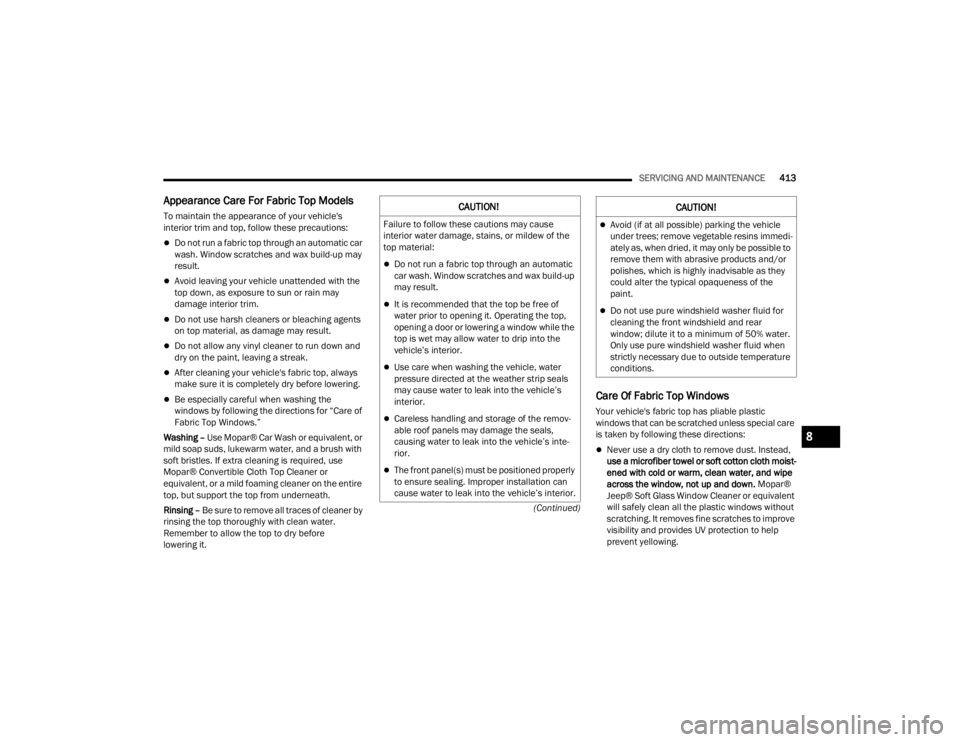
SERVICING AND MAINTENANCE413
(Continued)
Appearance Care For Fabric Top Models
To maintain the appearance of your vehicle's
interior trim and top, follow these precautions:
Do not run a fabric top through an automatic car
wash. Window scratches and wax build-up may
result.
Avoid leaving your vehicle unattended with the
top down, as exposure to sun or rain may
damage interior trim.
Do not use harsh cleaners or bleaching agents
on top material, as damage may result.
Do not allow any vinyl cleaner to run down and
dry on the paint, leaving a streak.
After cleaning your vehicle's fabric top, always
make sure it is completely dry before lowering.
Be especially careful when washing the
windows by following the directions for “Care of
Fabric Top Windows.”
Washing – Use Mopar® Car Wash or equivalent, or
mild soap suds, lukewarm water, and a brush with
soft bristles. If extra cleaning is required, use
Mopar® Convertible Cloth Top Cleaner or
equivalent, or a mild foaming cleaner on the entire
top, but support the top from underneath.
Rinsing – Be sure to remove all traces of cleaner by
rinsing the top thoroughly with clean water.
Remember to allow the top to dry before
lowering it.Care Of Fabric Top Windows
Your vehicle's fabric top has pliable plastic
windows that can be scratched unless special care
is taken by following these directions:
Never use a dry cloth to remove dust. Instead,
use a microfiber towel or soft cotton cloth moist -
ened with cold or warm, clean water, and wipe
across the window, not up and down. Mopar®
Jeep® Soft Glass Window Cleaner or equivalent
will safely clean all the plastic windows without
scratching. It removes fine scratches to improve
visibility and provides UV protection to help
prevent yellowing.
CAUTION!
Failure to follow these cautions may cause
interior water damage, stains, or mildew of the
top material:
Do not run a fabric top through an automatic
car wash. Window scratches and wax build-up
may result.
It is recommended that the top be free of
water prior to opening it. Operating the top,
opening a door or lowering a window while the
top is wet may allow water to drip into the
vehicle’s interior.
Use care when washing the vehicle, water
pressure directed at the weather strip seals
may cause water to leak into the vehicle’s
interior.
Careless handling and storage of the remov -
able roof panels may damage the seals,
causing water to leak into the vehicle’s inte -
rior.
The front panel(s) must be positioned properly
to ensure sealing. Improper installation can
cause water to leak into the vehicle’s interior.
Avoid (if at all possible) parking the vehicle
under trees; remove vegetable resins immedi -
ately as, when dried, it may only be possible to
remove them with abrasive products and/or
polishes, which is highly inadvisable as they
could alter the typical opaqueness of the
paint.
Do not use pure windshield washer fluid for
cleaning the front windshield and rear
window; dilute it to a minimum of 50% water.
Only use pure windshield washer fluid when
strictly necessary due to outside temperature
conditions.
CAUTION!
8
23_JT_OM_EN_USC_t.book Page 413
Page 416 of 448

414SERVICING AND MAINTENANCE
(Continued)
When washing, never use hot water or anything
stronger than a mild soap. Never use solvents
such as alcohol or harsh cleaning agents.
Always rinse thoroughly with cold water, then
wipe with a soft and slightly moist, clean cloth.
When removing frost, snow, or ice, never use a
scraper or de-icing chemicals. Use warm water
only if you must clean the window quickly.
Debris (sand, mud/dirt, dust, or salt) from
off-road driving will have an impact on plastic
retainer operation. Even normal on-road driving
and vehicle washing will eventually impact
window plastic retainer operation. To maintain
ease of use of the window plastic retainers,
each window plastic retainer should be cleaned
and lubricated regularly. Clean them with a mild
soap solution and a small brush. Cleaning prod -
ucts are available through an authorized dealer.
Never paste stickers, gummed labels or any
tape to the windows. Adhesives are hard to
remove and may damage the windows.
INTERIORS
CARPET SAFETY INFORMATION
Always use carpet designed to fit your vehicle. Only
use carpet that does not interfere with the
operation of the pedal assemblies. Only operate
the vehicle when the carpet is securely attached by
the grommets so it cannot slip out of position and
interfere with the pedal assemblies or impair safe
operation of your vehicle in other ways.
WARNING!
If operating the vehicle without carpet in place
the floor may become hot, and there is a risk
of burns.
An improperly attached, damaged, folded, or
damaged grommets may cause your carpet to
interfere with the accelerator, brake, or clutch
pedals and cause a loss of vehicle control. To
prevent SERIOUS INJURY or DEATH: ALWAYS
securely attach your carpet using the grom -
mets.
ALWAYS make sure objects cannot fall or slide
into the driver’s side floor area when the
vehicle is moving. Objects can become
trapped under accelerator, brake, or clutch
pedals and could cause a loss of vehicle
control.
NEVER place any objects under the carpet
(e.g., towels, keys, etc.). These objects could
change the position of the carpet and may
cause interference with the accelerator,
brake, or clutch pedals.
ONLY install carpet designed to fit your
vehicle. NEVER install carpet that cannot be
properly attached and secured to your vehicle.
If the carpet needs to be replaced, only use
manufacturer approved carpet for the specific
make, model, and year of your vehicle.
If the vehicle carpet has been removed and
re-installed, always properly attach carpet to
the floor and check that the floor mat
fasteners are secure to the vehicle carpet.
Fully depress each pedal to check for interfer -
ence with the accelerator, brake, or clutch
pedals then re-install the floor mats.
WARNING!
23_JT_OM_EN_USC_t.book Page 414
Page 422 of 448
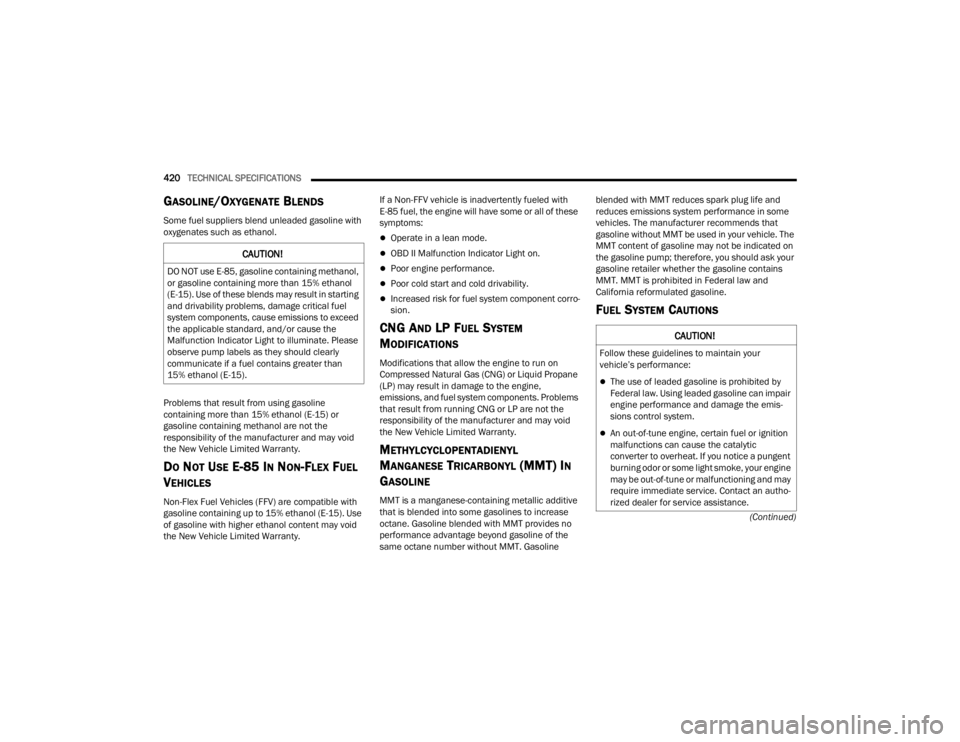
420TECHNICAL SPECIFICATIONS
(Continued)
GASOLINE/OXYGENATE BLENDS
Some fuel suppliers blend unleaded gasoline with
oxygenates such as ethanol.
Problems that result from using gasoline
containing more than 15% ethanol (E-15) or
gasoline containing methanol are not the
responsibility of the manufacturer and may void
the New Vehicle Limited Warranty.
DO NOT USE E-85 IN NON-FLEX FUEL
V
EHICLES
Non-Flex Fuel Vehicles (FFV) are compatible with
gasoline containing up to 15% ethanol (E-15). Use
of gasoline with higher ethanol content may void
the New Vehicle Limited Warranty. If a Non-FFV vehicle is inadvertently fueled with
E-85 fuel, the engine will have some or all of these
symptoms:
Operate in a lean mode.
OBD II Malfunction Indicator Light on.
Poor engine performance.
Poor cold start and cold drivability.
Increased risk for fuel system component corro
-
sion.
CNG AND LP FUEL SYSTEM
M
ODIFICATIONS
Modifications that allow the engine to run on
Compressed Natural Gas (CNG) or Liquid Propane
(LP) may result in damage to the engine,
emissions, and fuel system components. Problems
that result from running CNG or LP are not the
responsibility of the manufacturer and may void
the New Vehicle Limited Warranty.
METHYLCYCLOPENTADIENYL
M
ANGANESE TRICARBONYL (MMT) IN
G
ASOLINE
MMT is a manganese-containing metallic additive
that is blended into some gasolines to increase
octane. Gasoline blended with MMT provides no
performance advantage beyond gasoline of the
same octane number without MMT. Gasoline blended with MMT reduces spark plug life and
reduces emissions system performance in some
vehicles. The manufacturer recommends that
gasoline without MMT be used in your vehicle. The
MMT content of gasoline may not be indicated on
the gasoline pump; therefore, you should ask your
gasoline retailer whether the gasoline contains
MMT. MMT is prohibited in Federal law and
California reformulated gasoline.
FUEL SYSTEM CAUTIONS
CAUTION!
DO NOT use E-85, gasoline containing methanol,
or gasoline containing more than 15% ethanol
(E-15). Use of these blends may result in starting
and drivability problems, damage critical fuel
system components, cause emissions to exceed
the applicable standard, and/or cause the
Malfunction Indicator Light to illuminate. Please
observe pump labels as they should clearly
communicate if a fuel contains greater than
15% ethanol (E-15).
CAUTION!
Follow these guidelines to maintain your
vehicle’s performance:
The use of leaded gasoline is prohibited by
Federal law. Using leaded gasoline can impair
engine performance and damage the emis
-
sions control system.
An out-of-tune engine, certain fuel or ignition
malfunctions can cause the catalytic
converter to overheat. If you notice a pungent
burning odor or some light smoke, your engine
may be out-of-tune or malfunctioning and may
require immediate service. Contact an autho -
rized dealer for service assistance.
23_JT_OM_EN_USC_t.book Page 420
Page 429 of 448
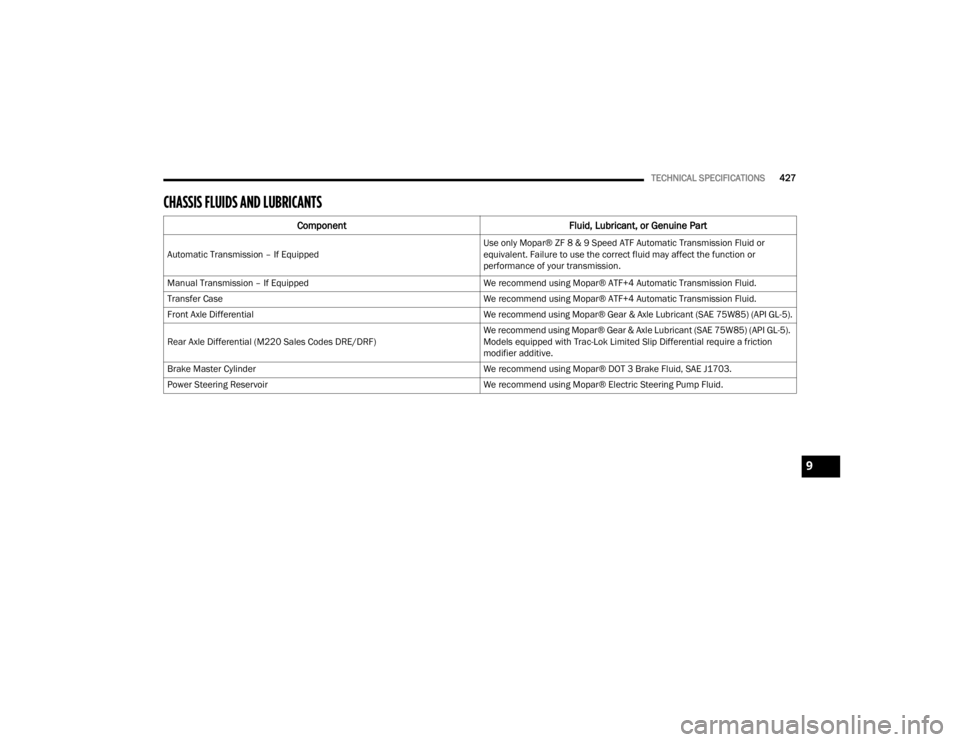
TECHNICAL SPECIFICATIONS427
CHASSIS FLUIDS AND LUBRICANTS
Component Fluid, Lubricant, or Genuine Part
Automatic Transmission – If Equipped
Use only Mopar® ZF 8 & 9 Speed ATF Automatic Transmission Fluid or
equivalent. Failure to use the correct fluid may affect the function or
performance of your transmission.
Manual Transmission – If Equipped We recommend using Mopar® ATF+4 Automatic Transmission Fluid.
Transfer Case We recommend using Mopar® ATF+4 Automatic Transmission Fluid.
Front Axle Differential We recommend using Mopar® Gear & Axle Lubricant (SAE 75W85) (API GL-5).
Rear Axle Differential (M220 Sales Codes DRE/DRF) We recommend using Mopar® Gear & Axle Lubricant (SAE 75W85) (API GL-5).
Models equipped with Trac-Lok Limited Slip Differential require a friction
modifier additive.
Brake Master Cylinder We recommend using Mopar® DOT 3 Brake Fluid, SAE J1703.
Power Steering Reservoir We recommend using Mopar® Electric Steering Pump Fluid.
9
23_JT_OM_EN_USC_t.book Page 427
Page 435 of 448

433
INDEX
A
About Your Brakes......................................... 418Accessory Drive Belt Inspection..................... 372Adaptive Cruise Control (ACC)
(Cruise Control).............................................. 173Adding Engine Coolant (Antifreeze)............... 378Adding Fuel.......................................... 191, 192Additives, Fuel............................................... 419Advance Phone Connectivity......................... 252Air BagAir Bag Operation...................................... 308Air Bag Warning Light............. 132, 306, 309Enhanced Accident Response......... 317, 352Event Data Recorder (EDR)....................... 352Front Air Bag................................... 307, 309If Deployment Occurs................................ 316Knee Impact Bolsters................................ 314Maintaining Your Air Bag System.............. 317Maintenance............................................. 317Redundant Air Bag Warning Light.............307Transporting Pets...................................... 329Air Bag Light........................................ 306, 329Air Cleaner, Engine (Engine Air Cleaner
Filter)............................................................. 366Air Conditioner Maintenance......................... 372Air Conditioner Refrigerant.................. 372, 373
Air Conditioner System................................. 372Air Conditioning Filter..............................68, 373Air Conditioning System................................... 67Air Conditioning, Operating Tips....................... 67Air Filter........................................................ 366Air PressureTires......................................................... 402AlarmArm The System.......................................... 23Disarm The System..................................... 23Security Alarm............................................. 23Alterations/ModificationsVehicle......................................................... 11Android Auto........................................ 254, 255Android Auto™
S
........................................ 254Antifreeze (Engine Coolant)................. 377, 423Disposal................................................... 378Anti-Lock Brake System (ABS)............. 135, 279Apple CarPlay....................................... 254, 257Apple CarPlay®
S
...................................... 256Assist, Hill Start............................................. 283Audio Settings............................................... 240Audio Systems (Radio).................................. 214Auto Down Power Windows............................. 81Automatic Dimming Mirror............................... 51Automatic Door Locks...................................... 27
Automatic Headlights.......................................58Automatic High Beams.....................................58Automatic Temperature Control (ATC)..............67Automatic Transmission................................ 157Adding Fluid.............................................. 382Autostick................................................... 160Fluid And Filter Change............................. 382Fluid Change............................................. 382Fluid Level Check............................. 381, 382Fluid Type........................................ 382, 426Gear Ranges............................................. 157Special Additives...................................... 381Automatic Transmission Limp Home Mode... 159AutoPark....................................................... 145AUX..................................................................71Auxiliary Electrical Outlet (Power Outlet)..........77Auxiliary Power Outlet......................................77Auxiliary Switches............................................79Axle Fluid....................................................... 426Axle Lock.............................................. 165, 166
B
Battery.......................................................... 364Charging System Light.............................. 133Keyless Key Fob Replacement....................16Bed Lights........................................................59
11
23_JT_OM_EN_USC_t.book Page 433
Page 441 of 448

439
Mirrors
............................................................. 50Automatic Dimming..................................... 51Electric Powered......................................... 52Electric Remote........................................... 52Heated........................................................ 52Outside........................................................ 51Rearview..................................................... 50Vanity.......................................................... 51Mobile App.................................................... 260Modifications/Alterations Vehicle........................................................ 11Monitor, Tire Pressure System....................... 294Mopar Parts................................................... 431
N
New Vehicle Break-In Period................ 151, 152
O
Occupant Restraints...................................... 299Octane Rating, Gasoline (Fuel)............ 419, 424Off Road Pages.............................................. 277Accessory Gauges..................................... 278Drivetrain.................................................. 278Pitch And Roll............................................ 278Status Bar................................................. 277Off Road+...................................................... 168Oil Filter, Change........................................... 366Oil Filter, Selection......................................... 366Oil Life Reset — If Equipped
S
.................... 122Oil Reset........................................................ 122
Oil, Engine............................................ 365, 424Capacity.................................................... 423Checking................................................... 364Dipstick.................................................... 364Disposal................................................... 366Filter................................................ 366, 424Filter Disposal........................................... 366Identification Logo.................................... 366Materials Added To.................................. 366Recommendation............................ 365, 423Synthetic.................................................. 366Viscosity................................................... 423Operator ManualOwner's Manual........................................ 431Outside Rearview Mirrors................................ 51
P
Paint Care..................................................... 411Pair (Link) Uconnect Phone To A Mobile
Phone
S
..................................................... 246Parking Brake............................................... 152ParkSenseFront And Rear......................................... 184ParkSense System, Rear.............................. 184Passive Entry................................................... 25Pedestrian Warning System.......................... 293Personalized Main Menu Bar........................ 232Pets.............................................................. 329Phone Mode................................................. 244Placard, Tire And Loading Information.......... 400
PowerBrakes...................................................... 418Door Locks...................................................25Inverter........................................................78Mirrors.........................................................52Steering.................................................... 168Windows......................................................81Power Steering Fluid..................................... 426Pregnant Women And Seat Belts.................. 304Preparation For Jacking................................ 336Presets.......................................................... 240Pressure Washing......................................... 365PretensionersSeat Belts................................................. 304
Q
Qualcomm TrueWireless Stereo.......................75
R
Radial Ply Tires.............................................. 403Radiator Cap (Coolant Pressure Cap)............ 378RadioPresets..................................................... 240Radio Controls.............................................. 234Radio Mode................................................... 234Radio Operation................................... 234, 276Radio Remote Controls................................. 233Raising The Soft Top
S
..................................89Rear Axle (Differential).................................. 380Rear Camera................................................. 189
11
23_JT_OM_EN_USC_t.book Page 439